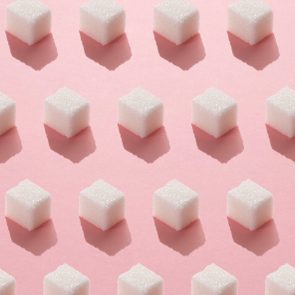12 Rules to Follow to Keep Blood Sugar Steady
Updated: Jun. 30, 2022
If you have type 2 diabetes or prediabetes, following expert-approved strategies to maintain your blood sugar levels is key to feeling great and controlling the condition. Here's what to do all day.
People with diabetes know how important it is to keep their blood sugar levels healthy, but avoiding blood sugar spikes takes some practice. Here’s some advice on how to keep blood sugar stable and prevent spikes, according to diabetes experts.
Think small-carb portions

Whether you’re managing low blood sugar symptoms or preventing levels from going too high, pay attention to the number of carbs you’re eating. “It’s the total amount of carbohydrate eaten at once that makes the most difference, says Virginia-based registered dietitian nutritionist Jill Weisenberger, author of Diabetes Weight Loss-Week by Week. “I teach my patients a very basic tenant: when you eat a few carbohydrates at a time, your blood glucose goes up a little. When you eat a lot of carbohydrates at a single meal or snack, it goes up a lot,” she says. And, as Weisenberger mentions, this is only a concern if you have type 2 or prediabetes, and less so in healthy people.
Eat (you guessed it) healthfully
If you’ve been recently diagnosed with type 2 diabetes, you may be experiencing a range of emotions, including stress and anxiety. “People are relieved to know that a healthy eating plan for people with diabetes is the same as it is for people without,” says registered dietitian nutritionist Toby Smithson, diabetes lifestyle expert and author of Diabetes Meal Planning and Nutrition for Dummies. The good news: there’s really no need to overthink it.

Aim for the rule of three
Digestion slows when you eat multiple nutrients at once (versus a carb-heavy food), says Weisenberger. Translation: you’ll feel fuller. “Nutrition and feelings of well-being are more complicated than blood sugar levels alone. Many of my patients find that they are better able to keep hunger at bay and their energy levels high when they eat meals balanced with three or more food groups with each of the macronutrients: protein, carbohydrate, and fat,” she says.
Balance your plate
Though there are many foods that are “bad” for diabetics, filling out your plate doesn’t have to be complicated. Start with low-cal, low-carb, non-starchy veggies, recommends Weisenberger. That includes spinach, broccoli, squash, and tomatoes. Then add whole grain and protein (salmon, chicken, beans). For satiating fat, grab a small portion of olive oil, nuts, or avocado. (Make sure you’re not making these diabetic eating mistakes that could impact your blood sugar levels.)
Know what “counts” as a carb
It’s not just your bread and pasta that falls into the carb category. Fruit, starchy veggies (potatoes, peas, corn), as well as milk and yogurt, are also considered carbohydrates. (Non-starchy veggies do contain carbs, but in much smaller amounts.)

Don’t fear fruit
Some types happen to be the healthiest fruits you can eat. That’s a good thing, too. Whether you’re grabbing an apple, berries, or pineapple, no fruit is off-limits, says Smithson. Just like carbohydrates, you want to pay attention in terms of 15-gram serving sizes. For example, a small apple, one cup of melon, or a half cup of canned fruit (in juice) are all equal to one serving.
Eat enough
While weight loss is important for people who have type 2 diabetes or prediabetes, it’s also critical to eat a satisfying amount of food, too. “Many people try to diet their diabetes away at the risk of being miserably hungry,” says Weisenberger. Remember that out-of-control hunger can have you reaching for not-so-nutritious choices like junk food which could affect your blood sugar levels.
Experiment with veggies
You already know that eating balanced meals includes a hefty dose of non-starchy veggies. These not only provide vitamins, minerals, and antioxidants, but they’re also essential in filling you up. The key? “Find veggies you enjoy, add variety, and experiment with ways to cook them to jazz them up,” says Smithson. For instance, try roasting radishes. (If you need help increasing your intake, here’s how to sneak more veggies into your diet.)

Start the day right
A simple breakfast can set your day up for healthy eating. Smithson recommends picking out a source of protein and carbs. That might mean a container of Greek yogurt. It contains both protein and carbs and is ideal if you’d rather have something small. Other options: eggs and a slice of toast or a serving of oatmeal with cheese.
Love legumes
If you have type 2 diabetes your goal is to increase your insulin sensitivity. Some specific foods help with this, like oats, barley, and legumes (like lentils). In fact, beans are one of the best foods for people with diabetes. Legumes’ fiber or resistant starch feeds healthy bacteria in the gut and can help decrease insulin resistance, explains Weisenberger. Still, watch portions, as these foods contain carbs, too.
Spice things up
Cinnamon, cumin, oregano, curry: add a boost of flavor to your meals with healthy herb and spices—these spices can help fight disease and ease insulin resistance, says Weisenberger. “Cook with them liberally.” She also mentions that they can help replace the amount of salt needed in the meal. (High blood pressure is a problem for two out of three people with diabetes; those with the condition are advised to limit sodium consumption.)

Learn your numbers
How a meal or snack will affect your blood sugar levels differs from person-to-person. Weisenberger recommends measuring your level just before eating and two hours after the first bite. The difference you see is mostly from the food, she says. Knowing those numbers can help give you an idea of how to make the healthiest choices for you.





















